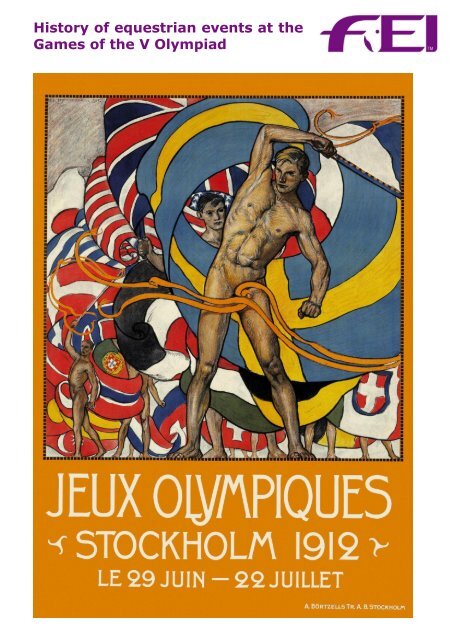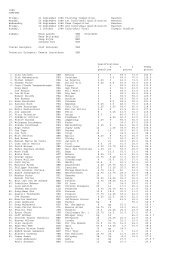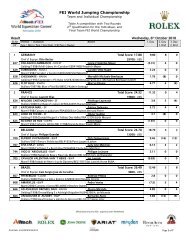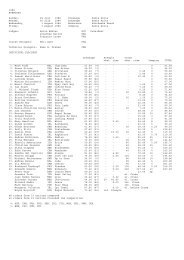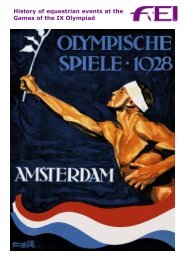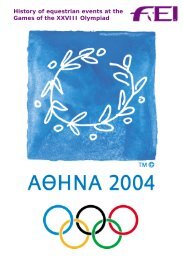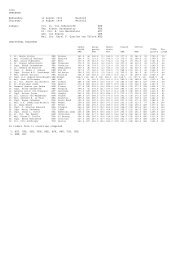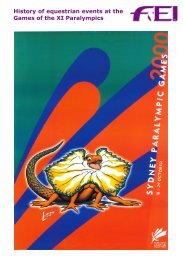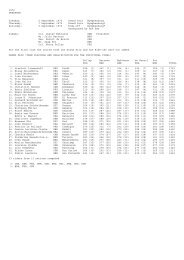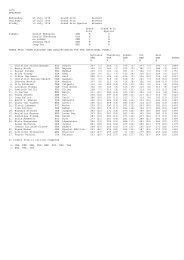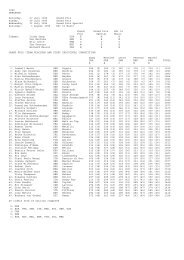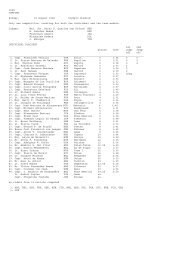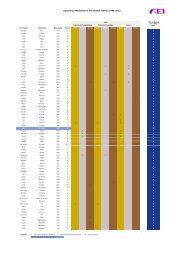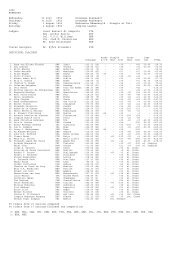History of equestrian events at the Games of the V ... - FEI History Hub
History of equestrian events at the Games of the V ... - FEI History Hub
History of equestrian events at the Games of the V ... - FEI History Hub
You also want an ePaper? Increase the reach of your titles
YUMPU automatically turns print PDFs into web optimized ePapers that Google loves.
<strong>History</strong> <strong>of</strong> <strong>equestrian</strong> <strong>events</strong> <strong>at</strong> <strong>the</strong><br />
<strong>Games</strong> <strong>of</strong> <strong>the</strong> V Olympiad
<strong>History</strong> <strong>of</strong> <strong>equestrian</strong> <strong>events</strong> <strong>at</strong> <strong>the</strong> 1912<br />
Olympic <strong>Games</strong> in Stockholm, Sweden<br />
<strong>Games</strong> <strong>of</strong> <strong>the</strong> V Olympiad<br />
Stockholm (SWE), 5 May – 27 July 1912<br />
A MODEL OF EFFICIENCY<br />
The 1912 Olympic <strong>Games</strong>, held in Stockholm, were opened on S<strong>at</strong>urday 6 July 1912 by<br />
King Gustav V. They were a model <strong>of</strong> efficiency and set <strong>the</strong> standard for organis<strong>at</strong>ion for<br />
decades to come. For <strong>the</strong> first time new technology was used with electronic timing<br />
devices for <strong>the</strong> track and field <strong>events</strong> and <strong>the</strong> use <strong>of</strong> <strong>the</strong> first public address system.<br />
The success <strong>of</strong> <strong>the</strong>se <strong>Games</strong> allowed <strong>the</strong> Olympic Movement to survive <strong>the</strong> interruption<br />
caused by World War I.<br />
<strong>Games</strong> Facts & figures<br />
For <strong>the</strong> first time, competitors came from all five continents.<br />
28 n<strong>at</strong>ions<br />
2,407 <strong>at</strong>hletes (48 women; 2,359 men)<br />
14 sports<br />
487 foreign <strong>of</strong>ficials<br />
260 foreign journalists<br />
a total <strong>of</strong> 327,288 spect<strong>at</strong>ors in <strong>the</strong> Olympic Stadium<br />
FINANCING THE GAMES<br />
For <strong>the</strong> financing <strong>of</strong> <strong>the</strong> <strong>Games</strong> <strong>the</strong> Swedes found <strong>the</strong> unique formula th<strong>at</strong> each sport had<br />
independent control <strong>of</strong> its economy. Alloc<strong>at</strong>ions from <strong>the</strong> Swedish government or from<br />
general sports authorities were only granted to <strong>the</strong> various sport committees if a fixed<br />
budget was not exceeded. In <strong>the</strong> case <strong>of</strong> <strong>the</strong> <strong>equestrian</strong> competitions, <strong>the</strong> budget was set<br />
<strong>at</strong> Crowns 100,000 (=£5,550 or $27,750). The final figures were: income 123,539<br />
Crowns; expenses 103,992 Crowns.<br />
It is interesting to note th<strong>at</strong> in 1912 a franchising system was already in place. Swedish<br />
firms could buy sole rights in connection with <strong>the</strong> <strong>Games</strong>, such as <strong>the</strong> sale <strong>of</strong> postcards, <strong>the</strong><br />
hiring-out <strong>of</strong> field-glasses, or <strong>the</strong> sale <strong>of</strong> fans. All in all <strong>the</strong> fifth Olympic <strong>Games</strong> had a total<br />
income <strong>of</strong> Crowns 2.5 million (=£136,082 or =$680,410). The pr<strong>of</strong>it was Crowns 4,646.51.<br />
FIRST OLYMPIC EQUESTRIAN EVENTS<br />
The <strong>Games</strong> <strong>of</strong> <strong>the</strong> V Olympiad were awarded to Stockholm, whose bid contained a proposal<br />
to hold <strong>equestrian</strong> <strong>events</strong>. It is interesting to note th<strong>at</strong> in <strong>the</strong> <strong>of</strong>ficial Stockholm report on<br />
<strong>the</strong> <strong>equestrian</strong> <strong>events</strong> it is st<strong>at</strong>ed th<strong>at</strong>, “It was first <strong>at</strong> <strong>the</strong> Olympic <strong>Games</strong> <strong>of</strong> Stockholm<br />
th<strong>at</strong> horse riding competitions were placed on <strong>the</strong> programme <strong>of</strong> <strong>the</strong> modern Olympiads.”<br />
It was <strong>the</strong> Master <strong>of</strong> <strong>the</strong> Horse to <strong>the</strong> Swedish King and IOC member, Count Clarence von<br />
Rosen, who since 1906 had begun pushing for <strong>the</strong> inclusion <strong>of</strong> <strong>the</strong> horse in <strong>the</strong> Olympic<br />
<strong>Games</strong>. By <strong>the</strong> inclusion <strong>of</strong> military represent<strong>at</strong>ives, he argued, <strong>the</strong> Olympic <strong>Games</strong> would<br />
be streng<strong>the</strong>ned and <strong>the</strong> various governments would show more interest. Baron de<br />
Coubertin and many IOC members were supportive and asked von Rosen to present a<br />
proposal for horse competitions. The programme included prize riding (dressage), a ridingpent<strong>at</strong>hlon<br />
and jeu de rose.<br />
The organisers <strong>of</strong> <strong>the</strong> 1908 Olympic <strong>Games</strong> in London were responsive and agreed to place<br />
horse-riding competitions on <strong>the</strong> programme <strong>of</strong> 1908. However, <strong>the</strong> British Olympic<br />
Council was not able to arrange <strong>the</strong> horse-riding competitions in <strong>the</strong> stadium.<br />
2
<strong>History</strong> <strong>of</strong> <strong>equestrian</strong> <strong>events</strong> <strong>at</strong> <strong>the</strong> 1912<br />
Olympic <strong>Games</strong> in Stockholm, Sweden<br />
Consequently <strong>the</strong> newly-cre<strong>at</strong>ed Olympia Horse Show was contacted and agreed to hold<br />
<strong>the</strong> competitions in <strong>the</strong> Olympia Hall if six n<strong>at</strong>ions would enter <strong>at</strong> least four represent<strong>at</strong>ives.<br />
When eight n<strong>at</strong>ions entered a total <strong>of</strong> 88 competitors, <strong>the</strong> Olympia board found itself<br />
unable to carry out <strong>the</strong> programme.<br />
TO PAY OR NOT TO PAY … PRIZE MONEY TO GENTLEMEN RIDERS<br />
After Stockholm was given <strong>the</strong> task <strong>of</strong> organising <strong>the</strong> 1912 Olympic <strong>Games</strong>, <strong>the</strong> inclusion <strong>of</strong><br />
horse riding was undisputed. It was von Rosen’s home country and as Royal Equerry he<br />
was a very influential personality. There was, however, one m<strong>at</strong>ter to be clarified: should<br />
prize money be paid out. The Swedish organising committee secured 50,000 crowns for<br />
this purpose. Then, on 11 June 1910, <strong>the</strong> IOC meeting in Luxembourg determined th<strong>at</strong> only<br />
medals and no money prizes were to be awarded <strong>at</strong> <strong>the</strong> <strong>Games</strong>, in all sports. Pr<strong>of</strong>essionals<br />
were excluded from <strong>the</strong> <strong>Games</strong> and only gentlemen riders were allowed - <strong>the</strong> definition<br />
<strong>of</strong> a gentleman rider being left to <strong>the</strong> regul<strong>at</strong>ions <strong>of</strong> <strong>the</strong> particip<strong>at</strong>ing countries.<br />
NEW PROGRAMME<br />
The Swedish Organising Committee realised th<strong>at</strong> only a few intern<strong>at</strong>ional feder<strong>at</strong>ions<br />
existed and, consequently, <strong>the</strong>re were few universally accepted rules. They adopted <strong>the</strong><br />
following procedure: if <strong>the</strong>re were rules <strong>of</strong> an intern<strong>at</strong>ional sports feder<strong>at</strong>ion or if <strong>the</strong>re<br />
were rules adopted intern<strong>at</strong>ionally, <strong>the</strong>y would be used, such as for cycling, football, tennis,<br />
swimming or yachting. If such universally accepted rules did not exist, such as in horse<br />
riding, <strong>the</strong> Swedish organising committee would draw up <strong>the</strong> rules for <strong>the</strong> <strong>Games</strong> <strong>of</strong> 1912.<br />
Consequently, Count Von Rosen re-thought <strong>the</strong> Olympic <strong>equestrian</strong> programme and came<br />
up with <strong>the</strong> three discipline set-up still in force today: Dressage, Eventing and<br />
Jumping. Von Rosen ignored driving, polo, vaulting and endurance riding. He also discarded<br />
<strong>the</strong> <strong>the</strong>n very popular high-jump competition because it was mostly pr<strong>of</strong>essional riders who<br />
were involved.<br />
Equestrian facts & figures<br />
10 n<strong>at</strong>ions (Belgium, Chile, Denmark, France, Germany, Gre<strong>at</strong> Britain, Norway,<br />
Russia, Sweden, USA)<br />
62 riders / 70 horses<br />
88 entries (40 in Jumping; 21 in Dressage; 27 in Eventing)<br />
The two days <strong>of</strong> <strong>equestrian</strong> sport in <strong>the</strong> Olympic Stadium (16 July 1912 - Jumping <strong>of</strong><br />
Eventing and Individual Jumping; 17 July 1912 - Dressage <strong>of</strong> Eventing and Team<br />
Jumping) <strong>at</strong>tracted 17,250 and 9,881 spect<strong>at</strong>ors respectively.<br />
It took two years – 1910 and 1911 - to construct <strong>the</strong> new brick-built Olympic<br />
Stadium, which, 44 years and 78 years l<strong>at</strong>er, served for <strong>the</strong> 1956 Olympic Equestrian<br />
<strong>Games</strong> and <strong>the</strong> 1990 <strong>FEI</strong> World Equestrian <strong>Games</strong> respectively.<br />
Sweden and Germany fielded full teams in all disciplines. Six o<strong>the</strong>r countries –<br />
Belgium, Denmark, France, Gre<strong>at</strong> Britain, Norway and <strong>the</strong> USA – sent a limited<br />
number <strong>of</strong> riders and horses, who were <strong>of</strong>ten used in two or even all three disciplines.<br />
Russia had a six-man jumping team and one dressage rider, while Chile deleg<strong>at</strong>ed two<br />
<strong>of</strong>ficers who were <strong>at</strong> th<strong>at</strong> time <strong>at</strong> <strong>the</strong> German cavalry school in Hannover.<br />
JUMPING (40 riders from eight n<strong>at</strong>ions)<br />
There were separ<strong>at</strong>e competitions for <strong>the</strong> individual and team medals, although both were<br />
over <strong>the</strong> same course <strong>of</strong> 15 obstacles, four <strong>of</strong> which had to be jumped twice. There were 29<br />
jumping efforts. The maximum height was 1.40m, maximum width 4.00m, and speed 400<br />
m/min.<br />
3
<strong>History</strong> <strong>of</strong> <strong>equestrian</strong> <strong>events</strong> <strong>at</strong> <strong>the</strong> 1912<br />
Olympic <strong>Games</strong> in Stockholm, Sweden<br />
Six riders per country were allowed in <strong>the</strong> individual competition.<br />
Medallists – Individual<br />
1. Gold Jean Cariou (FRA) Mignon<br />
2. Silver Rabod W. von Kröcher (GER) Dohna<br />
3. Bronze Emmanuel de Blommaert (BEL) Clonmore<br />
Medallists – Team<br />
1. Gold Sweden<br />
2. Silver France<br />
3. Bronze Germany<br />
Gustaf KILMAN (Gätan),<br />
Frederik ROSENCRANTZ (Drabant),<br />
Carl Gustaf LEWENHAUPT (Medusa),<br />
Hans VON ROSEN (Lord Iron)<br />
DUFOURT D’ASTAFORT (Amazone),<br />
Jean CARIOU (Mignon),<br />
V.MEYER (Allons-Y),<br />
G. SEIGNER (Cocotte)<br />
Sigismund FREYER (Ultimus),<br />
Willi VON HOHENAU (Pretty Girl),<br />
Ernst DELOCH (<strong>Hub</strong>ertus),<br />
Friedrich Karl VON PREUSSEN (Gibson Boy)<br />
DRESSAGE (21 riders from eight n<strong>at</strong>ions)<br />
The 1912 Dressage test did not contain piaffe and passage, but five jumps up to 1.10m. At<br />
<strong>the</strong> end <strong>of</strong> <strong>the</strong> programme <strong>the</strong> horses had to jump a painted cylinder rolling towards <strong>the</strong>m.<br />
There were bonus points to be won when <strong>the</strong> rider held <strong>the</strong> reins in one hand.<br />
Medallists – Individual<br />
1. Gold Carl Bonde (SWE) Emperor<br />
2. Silver Gustaf A. Boltenstern (SWE) Neptun<br />
3. Bronze Hans von Blixen-Finecke (SWE) Maggie<br />
Medallists – Team<br />
In 1912, 1920, 1924 no team medals were distributed<br />
4
<strong>History</strong> <strong>of</strong> <strong>equestrian</strong> <strong>events</strong> <strong>at</strong> <strong>the</strong> 1912<br />
Olympic <strong>Games</strong> in Stockholm, Sweden<br />
EVENTING (27 riders from seven n<strong>at</strong>ions)<br />
Only 10 years after a Championn<strong>at</strong> du Cheval d’Armes was held for <strong>the</strong> first time in France,<br />
<strong>the</strong> Olympic “Military” was organised in Stockholm. Only teams <strong>of</strong> three or four riders were<br />
allowed and <strong>the</strong>y had to be <strong>of</strong>ficers on <strong>the</strong>ir own horses belonging to <strong>the</strong>ir army. The<br />
competition was held over five days (with one rest day), as follow:<br />
1 st day: A: Endurance ride over 55km in 4 hours<br />
Including:<br />
B:Cross-country over 5 km in 15 minutes (12 obstacles)<br />
3 rd day: C: Steeplechase over 3500m. in 5 minutes and 50 seconds (10 obstacles)<br />
4 th day: D: Jumping over 15 obstacles, up to 1.30m high and 3.00m wide<br />
5 th day: E: Dressage<br />
In each <strong>of</strong> <strong>the</strong> five phases a maximum <strong>of</strong> 10 points could be won.<br />
Sweden took <strong>the</strong> team gold medal ahead <strong>of</strong> Germany and <strong>the</strong> United St<strong>at</strong>es. Member <strong>of</strong> <strong>the</strong><br />
l<strong>at</strong>ter was Capt. Guy Henry on Chiswell. In <strong>the</strong> early thirties General Henry was chief <strong>of</strong> <strong>the</strong><br />
US Cavalry and, during <strong>the</strong> 1932 Olympic <strong>Games</strong>, president <strong>of</strong> <strong>the</strong> <strong>FEI</strong>.<br />
Medallists – Individual<br />
1. Gold Axel Nordlander (SWE) Lady Artist<br />
2. Silver Harry von Rochow (GER) Idealist<br />
3. Bronze Jean Cariou (FRA) Cocotte<br />
Medallists – Team<br />
1. Gold Sweden<br />
2. Silver Germany<br />
3. Bronze USA<br />
Axel NORDLANDER (Lady Artist),<br />
Nils ADLERCREUTZ (Atout),<br />
Ernst CASPARSSON (Irmelin),<br />
Henric HORN AF AMINNE (Omen)<br />
Harry VON ROCHOW (Idealist),<br />
Eduard VON LUTCKEN (Blue Boy),<br />
Richard VON SCHAESBERG (Grundsee),<br />
Carl VON MOERS (May Queen)<br />
Benjamin LEAR (Poppy),<br />
John C. MONTGOMERY (Deceive),<br />
Guy V. HENRY (Chiswell),<br />
Ephraim F. GRAHAM (Connie)<br />
World War I prevented <strong>the</strong> organis<strong>at</strong>ion <strong>of</strong> <strong>the</strong> 1916 Olympic <strong>Games</strong>. When <strong>at</strong> short notice<br />
in 1919, Antwerp, Belgium, accepted to stage <strong>the</strong> <strong>Games</strong> <strong>of</strong> <strong>the</strong> VII Olympiad in 1920, <strong>the</strong><br />
1912 programme, with some altern<strong>at</strong>ions, was used.<br />
5


